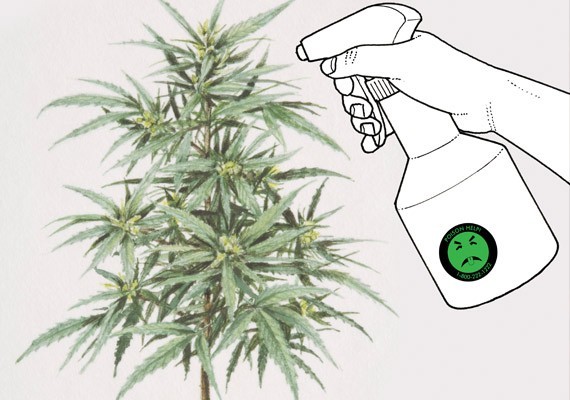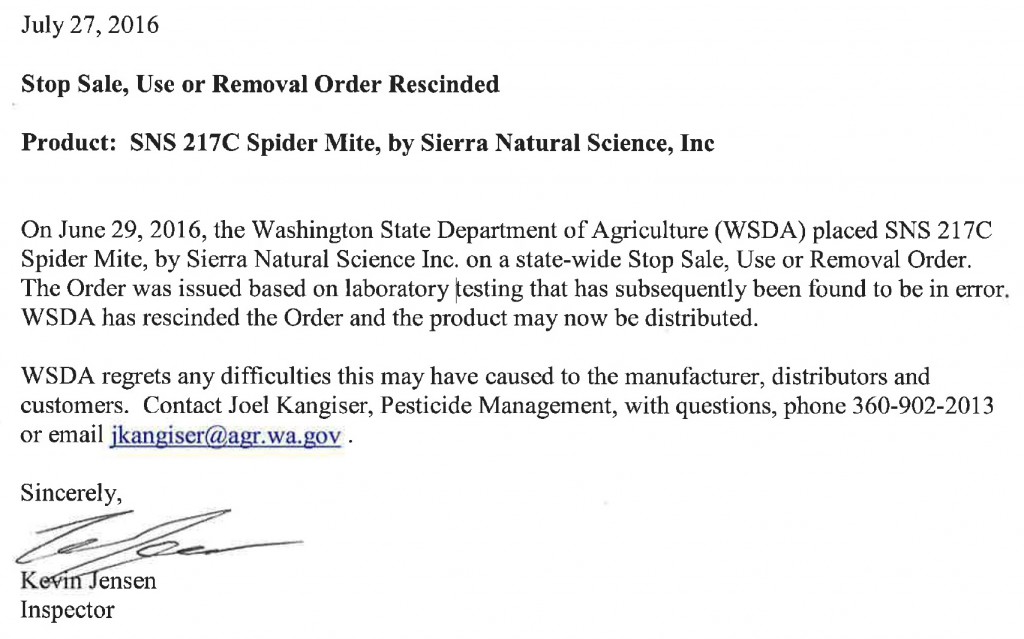Katelyn Baker
Well-Known Member
I got an interesting email yesterday from Erik Johansen, pesticide guru for the Washington State Department of Agriculture (WSDA). After the Guardian Mite Spray snafu, in which it was discovered that an allowed pesticide for cannabis secretly contained a disallowed pesticide, the agency decided to test some of the other crop aids commonly used in cannabis cultivation. This included some pesticides, as well as cloning agents, fertilizers, and nutritional supplements.
The state tested 27 products and found that 15 of them contained disallowed pesticides. Two of those 15 were pesticides that the state had previously approved for use, meaning that substances that growers thought were totally kosher to spray on their plants were totally not. Additionally, other products involved in the growing process that one would naturally assume to be pesticide-free were also found to contain banned pesticides.
The following is the list of the 15 products that tested positive for disallowed pesticides. The first two products are the pesticides that had previously been approved for use.
1. Safergro Mildew Cure for Powdery Mildew Control
2. SNS 217C All Natural Spider Mite Control Concentrate
3. Humboldt Roots
4. Olivia's Cloning Gel
5. Optic Foliar AT-AK
6. Optic Foliar Overgrow
7. Optic Foliar Switch
8. Rock Resinator Heavy Yields
9. Root 66 1-1-1
10. The Hammer
11. Frost Protection Plus
12. NPK Mighty Wash
13. OG Rapid Flower + Hardener
14. Pyyro K 0-3-7
15. Vita Grow Thunder Boom
This really sucks for growers, especially those who have tried to play by the rules. It probably also explains why so many growers were left scratching their heads during Pestgate, when their products came back with detectable levels of pesticides, even though they had never applied them.
I can't say it's that surprising though, given everything I've learned about how pesticides get onto pot. During Pestgate, Gordon Fagras, who owns the state's first lab equipped to test for pesticides, Trace Analytics, told me we were seeing a lot of small amounts of residual pesticides on pot because pesticides were "all around us." He was referring to spray drift from nearby food farms and genetic contamination from poorly vetted mother plants, but he also specifically mentioned fertilizer and nutrient additives as potential sources of inadvertent pesticide contamination. Lo and behold, he was right.
As a budtender buddy of mine, Bryson Chin, pointed out, some of the deceptively labeled products were industry standard for even those producers who have gone out of their way to get certified by third-party consumer protection organizations like Clean Green or Certified Kind.
"A lot of Clean Green producers use SNS 217," he said, "and Olivia's Cloning Gel is an industry favorite as well."
If you are a pot smoker, should you panic? Please don't!
Yes, disallowed pesticides could very well be on the pot you thought was safe. But the industry is in a far better place these days than before to monitor and track cannabis products.
For one, we have actual facilities to test cannabis for pesticides. Any producer who has been using these products can check their crops. Any retailer worried about contamination can check their products.
Two, the industry and the state have been working to keep better track of whose pot ends up in whose extraction rigs and in whose edibles and, ultimately, on whose shelves. Once pot gets extracted into oil and cooked into edibles, the traceability system gets a little hazy, but after Pestgate, producer/processors are at least aware that it behooves them to track the lot numbers for external material that goes into their own batches.
Three, we've actually set usable action levels for pesticides on pot, so we can easily determine if any pot is contaminated enough to be troubling, and we have an official recall protocol in place if it is. Also, any pesticide residue from these crop aids is likely to be minimal, as it is already a tiny component of the growing process. Fingers crossed, any pesticides detected will be well below that 0.1ppm threshold for human safety.
In other words, this is less of a clusterfuck than Pestgate, thank heavens.
Another important note: This means at least one state agency is taking proactive steps to clean up the dirtier parts of the cannabis industry. The WSDA has been regulating pesticides in other industries for ages, and increased involvement from them in the cannabis industry is definitely a good thing for consumers.
I happen to be driving around the state visiting pot farms with my friend Lena Davidson, who happens to be the primary cannabis buyer for botanicaSEATTLE, a major cannabis processor. Given that she's in the middle of the cannabis supply chain, I figured I might bug her for the industry's perspective on the issue.
"The upside of this is that it'll take the same pressure for producers to have best practices for consumer safety in their grows and push it back into their supply chain, which is entirely untouched by the same regulations the cannabis industry is subjected to," she said.
A very good point: Producers and processors are tightly regulated, but no one's asking the manufacturers of Merlin's Maxi-Bloom Green Magic Grow Gel what gives it its mystical powers. This is another one of the many, many growing pains of a brand new industry.
"It's like the industry is going through a cleanse," she joked, "but I've never known anybody that doesn't get grumpy during a cleanse. Cayenne, ginger, lemon, and pesticide test results."

News Moderator: Katelyn Baker 420 MAGAZINE ®
Full Article: Prohibited Pesticides Found In Commonly Used Pot-Growing Products
Author: Tobias Coughlin-Bogue
Contact: (206) 323-7101
Photo Credit: None Found
Website: The Stranger
The state tested 27 products and found that 15 of them contained disallowed pesticides. Two of those 15 were pesticides that the state had previously approved for use, meaning that substances that growers thought were totally kosher to spray on their plants were totally not. Additionally, other products involved in the growing process that one would naturally assume to be pesticide-free were also found to contain banned pesticides.
The following is the list of the 15 products that tested positive for disallowed pesticides. The first two products are the pesticides that had previously been approved for use.
1. Safergro Mildew Cure for Powdery Mildew Control
2. SNS 217C All Natural Spider Mite Control Concentrate
3. Humboldt Roots
4. Olivia's Cloning Gel
5. Optic Foliar AT-AK
6. Optic Foliar Overgrow
7. Optic Foliar Switch
8. Rock Resinator Heavy Yields
9. Root 66 1-1-1
10. The Hammer
11. Frost Protection Plus
12. NPK Mighty Wash
13. OG Rapid Flower + Hardener
14. Pyyro K 0-3-7
15. Vita Grow Thunder Boom
This really sucks for growers, especially those who have tried to play by the rules. It probably also explains why so many growers were left scratching their heads during Pestgate, when their products came back with detectable levels of pesticides, even though they had never applied them.
I can't say it's that surprising though, given everything I've learned about how pesticides get onto pot. During Pestgate, Gordon Fagras, who owns the state's first lab equipped to test for pesticides, Trace Analytics, told me we were seeing a lot of small amounts of residual pesticides on pot because pesticides were "all around us." He was referring to spray drift from nearby food farms and genetic contamination from poorly vetted mother plants, but he also specifically mentioned fertilizer and nutrient additives as potential sources of inadvertent pesticide contamination. Lo and behold, he was right.
As a budtender buddy of mine, Bryson Chin, pointed out, some of the deceptively labeled products were industry standard for even those producers who have gone out of their way to get certified by third-party consumer protection organizations like Clean Green or Certified Kind.
"A lot of Clean Green producers use SNS 217," he said, "and Olivia's Cloning Gel is an industry favorite as well."
If you are a pot smoker, should you panic? Please don't!
Yes, disallowed pesticides could very well be on the pot you thought was safe. But the industry is in a far better place these days than before to monitor and track cannabis products.
For one, we have actual facilities to test cannabis for pesticides. Any producer who has been using these products can check their crops. Any retailer worried about contamination can check their products.
Two, the industry and the state have been working to keep better track of whose pot ends up in whose extraction rigs and in whose edibles and, ultimately, on whose shelves. Once pot gets extracted into oil and cooked into edibles, the traceability system gets a little hazy, but after Pestgate, producer/processors are at least aware that it behooves them to track the lot numbers for external material that goes into their own batches.
Three, we've actually set usable action levels for pesticides on pot, so we can easily determine if any pot is contaminated enough to be troubling, and we have an official recall protocol in place if it is. Also, any pesticide residue from these crop aids is likely to be minimal, as it is already a tiny component of the growing process. Fingers crossed, any pesticides detected will be well below that 0.1ppm threshold for human safety.
In other words, this is less of a clusterfuck than Pestgate, thank heavens.
Another important note: This means at least one state agency is taking proactive steps to clean up the dirtier parts of the cannabis industry. The WSDA has been regulating pesticides in other industries for ages, and increased involvement from them in the cannabis industry is definitely a good thing for consumers.
I happen to be driving around the state visiting pot farms with my friend Lena Davidson, who happens to be the primary cannabis buyer for botanicaSEATTLE, a major cannabis processor. Given that she's in the middle of the cannabis supply chain, I figured I might bug her for the industry's perspective on the issue.
"The upside of this is that it'll take the same pressure for producers to have best practices for consumer safety in their grows and push it back into their supply chain, which is entirely untouched by the same regulations the cannabis industry is subjected to," she said.
A very good point: Producers and processors are tightly regulated, but no one's asking the manufacturers of Merlin's Maxi-Bloom Green Magic Grow Gel what gives it its mystical powers. This is another one of the many, many growing pains of a brand new industry.
"It's like the industry is going through a cleanse," she joked, "but I've never known anybody that doesn't get grumpy during a cleanse. Cayenne, ginger, lemon, and pesticide test results."

News Moderator: Katelyn Baker 420 MAGAZINE ®
Full Article: Prohibited Pesticides Found In Commonly Used Pot-Growing Products
Author: Tobias Coughlin-Bogue
Contact: (206) 323-7101
Photo Credit: None Found
Website: The Stranger






